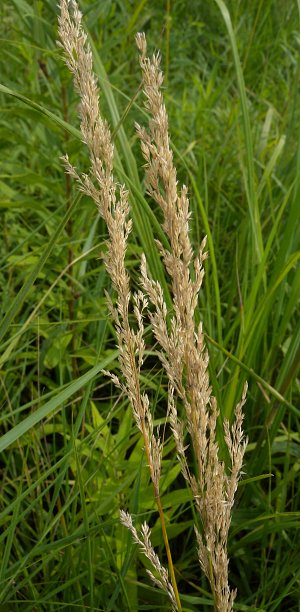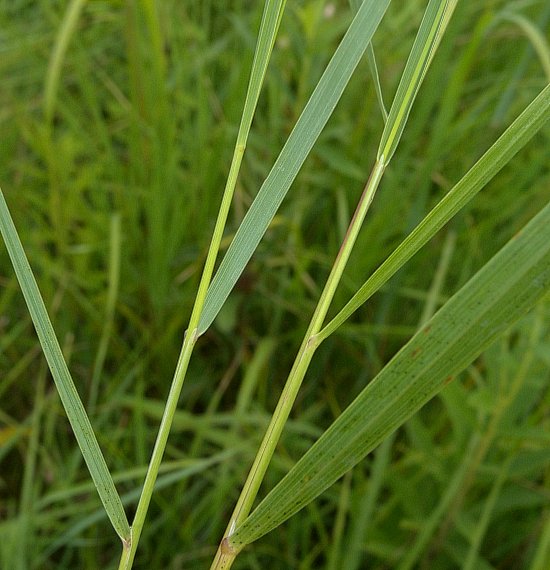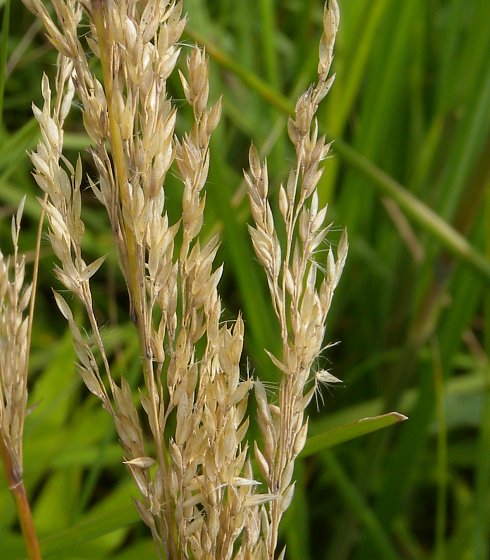 Description:
This perennial grass forms dense stands or tufted culms that are 2-5'
tall. In
areas where this species is more sparsely distributed, it resembles a
bunchgrass, while in other areas where it is dominant, this grass forms
a coarse sod. Both fertile and sterile shoots are produced. The culms
are light green or straw-colored (stramineus), terete, glabrous,
hollow, and unbranched. There are 5-10 alternate leaves along the
entire length of each culm. The leaf blades are 4-12" long, 4-8 mm.
across, and linear in shape; they tend to be widest toward the middle
or lower middle. The leaf blades are ascending to widely spreading and
rather floppy. The upper and lower surfaces of the leaf blades are pale
green, medium green, or blue-green; they are glabrous and sometimes
slightly glaucous. The leaf sheaths are pale green, longitudinally
veined, glabrous, and open; they are shorter than the internodes. The
ligules are white-membranous and 2-4 mm. in length; sometimes the
leaves become loose at their ligules. The nodes are slightly swollen,
glabrous, and dark-colored. Fertile culms terminate in panicles of
single-flowered spikelets (one panicle per culm). The peduncles of
these panicles are about 6-12" long. The panicles are 4-10" long and up
to one-half as much across. Depending on their stage of development and
the variety of this grass, these panicles can be open, loose, and
narrowly pyramidal in shape (as occurs during the blooming period,
particularly with var.
canadensis), or they can be rather dense and
contracted (as occurs before or after the blooming period, particularly
with var. macouniana).
The lateral branches of the panicle are up to 3"
long and they can be either erect, ascending, or widely spreading
below. These lateral branches subdivide into shorter secondary and
tertiary branches that terminate in pale green to
purplish spikelets. These branches are straight to slightly
curved, but not wiry. Each spikelet has a pair of glumes, a lemma, and
a floret. Depending on the variety of this grass, these spikelets vary
in their size; the spikelets of var.
canadensis are 3-4 mm. in length,
while the spikelets of var.
macouniana are 2-2.5 mm. in length. There
is also a third variety, var.
langsdorfi,
that has spikelets 4.5-6 mm.
in length, but it has not been found in Illinois thus far. The glumes
are the same length as the spikelets; they are narrowly lanceolate in
shape, glabrous, and convex to slightly keeled along their outer
surfaces. The lemmas are slightly shorter than the glumes by up to 0.5
mm.; they are narrowly lanceolate in shape, glabrous, convex along
their outer surfaces, and translucent toward their tips. Each lemma
also has a tuft of white hair at its base and a delicate straight awn
that extends from below the middle of the lemma to as high as its tip.
The tufted hairs are the same length as the lemma or less, while
extending
in different directions. Each floret has 3 stamens and a pair of
feathery
stigmata. The blooming period occurs from early to mid-summer, lasting
about 1-2 weeks for a colony of plants. The florets are
cross-pollinated by the wind. Afterwards, the panicles and their
spikelets become straw-colored during late summer, when the grains
become mature. The tufted lemmas and their grains are dispersed
by wind or water. Depending on the variety of this grass, the grains
vary in size from 1.25-2 mm. in length; they are narrowly
ellipsoid-oblongoid, light brown, glabrous, and very light in weight.
The root system is fibrous and rhizomatous. Clonal offsets develop from
the rhizomes. This grass occasionally forms large colonies at favorable
sites.
Description:
This perennial grass forms dense stands or tufted culms that are 2-5'
tall. In
areas where this species is more sparsely distributed, it resembles a
bunchgrass, while in other areas where it is dominant, this grass forms
a coarse sod. Both fertile and sterile shoots are produced. The culms
are light green or straw-colored (stramineus), terete, glabrous,
hollow, and unbranched. There are 5-10 alternate leaves along the
entire length of each culm. The leaf blades are 4-12" long, 4-8 mm.
across, and linear in shape; they tend to be widest toward the middle
or lower middle. The leaf blades are ascending to widely spreading and
rather floppy. The upper and lower surfaces of the leaf blades are pale
green, medium green, or blue-green; they are glabrous and sometimes
slightly glaucous. The leaf sheaths are pale green, longitudinally
veined, glabrous, and open; they are shorter than the internodes. The
ligules are white-membranous and 2-4 mm. in length; sometimes the
leaves become loose at their ligules. The nodes are slightly swollen,
glabrous, and dark-colored. Fertile culms terminate in panicles of
single-flowered spikelets (one panicle per culm). The peduncles of
these panicles are about 6-12" long. The panicles are 4-10" long and up
to one-half as much across. Depending on their stage of development and
the variety of this grass, these panicles can be open, loose, and
narrowly pyramidal in shape (as occurs during the blooming period,
particularly with var.
canadensis), or they can be rather dense and
contracted (as occurs before or after the blooming period, particularly
with var. macouniana).
The lateral branches of the panicle are up to 3"
long and they can be either erect, ascending, or widely spreading
below. These lateral branches subdivide into shorter secondary and
tertiary branches that terminate in pale green to
purplish spikelets. These branches are straight to slightly
curved, but not wiry. Each spikelet has a pair of glumes, a lemma, and
a floret. Depending on the variety of this grass, these spikelets vary
in their size; the spikelets of var.
canadensis are 3-4 mm. in length,
while the spikelets of var.
macouniana are 2-2.5 mm. in length. There
is also a third variety, var.
langsdorfi,
that has spikelets 4.5-6 mm.
in length, but it has not been found in Illinois thus far. The glumes
are the same length as the spikelets; they are narrowly lanceolate in
shape, glabrous, and convex to slightly keeled along their outer
surfaces. The lemmas are slightly shorter than the glumes by up to 0.5
mm.; they are narrowly lanceolate in shape, glabrous, convex along
their outer surfaces, and translucent toward their tips. Each lemma
also has a tuft of white hair at its base and a delicate straight awn
that extends from below the middle of the lemma to as high as its tip.
The tufted hairs are the same length as the lemma or less, while
extending
in different directions. Each floret has 3 stamens and a pair of
feathery
stigmata. The blooming period occurs from early to mid-summer, lasting
about 1-2 weeks for a colony of plants. The florets are
cross-pollinated by the wind. Afterwards, the panicles and their
spikelets become straw-colored during late summer, when the grains
become mature. The tufted lemmas and their grains are dispersed
by wind or water. Depending on the variety of this grass, the grains
vary in size from 1.25-2 mm. in length; they are narrowly
ellipsoid-oblongoid, light brown, glabrous, and very light in weight.
The root system is fibrous and rhizomatous. Clonal offsets develop from
the rhizomes. This grass occasionally forms large colonies at favorable
sites.
Cultivation: The preference is full or partial sun, wet to moist conditions, and cool to warm summer temperatures. This grass adapts to a variety of soil types, including loam, clay, silt, sand, or some combination of the preceding types. It also has a broad pH tolerance. Standing water is tolerated by this grass if it doesn't persist throughout the growing season. Winter-hardiness is excellent. At some locations, this grass may spread aggressively. It is more easily established by division of its rhizomes, as the small seedlings are delicate.
Range & Habitat: The native Bluejoint Grass is occasional in the northern two-thirds of Illinois, becoming rare or absent in the southern section of the state (see Distribution Map). It tends to become more common northward. Habitats include wet to moist prairies, wet to moist sand prairies, wet to moist dolomite prairies, prairie swales, sedge meadows, marshes, bogs, fens, sandy pannes near Lake Michigan, swamps, and poorly drained areas along railroads. In some of these habitats, Bluejoint Grass may be the dominant or codominant ground vegetation. Unfortunately, many of the wetlands where this grass once occurred in great abundance have been destroyed, although it is still occurs in smaller stands at scattered locations.

Faunal Associations: Insects that feed, or probably feed, on Bluejoint Grass and other Calamagrostis spp. include the plant bug Collaria meilleurii, the aphids Atheroides serrulatus and Sitobion beiquei, the leafhoppers Hecalus major and Cribrus shingwauki, and Orchellimum delicatum (Delicate Meadow Katydid). Bluejoint Grass has been used as a source of forage and hay for cattle and horses, and it is also eaten by the American Bison and elk. It is more palatable during the spring before the seedheads develop. The roots and lower stems of this grass are eaten by muskrats to a minor extent (Hamerstrom & Blake, 1939). Because this grass often forms colonies and it is fairly tall, it provides nesting habitat for many wetland birds and good cover for small mammals, snakes, birds, and other wildlife.
Photographic Location: A restored prairie at Meadowbrook Park in Urbana, Illinois. The photographed grass is Calamagrostis canadensis macouniana.

Comments: This wetland grass is distinguished by glumes that are slightly longer than the lemmas, tufts of hair at the bases of the lemmas, unbranched stems, and its medium-large size. The leaf blades are often bluish green. Bluejoint Grass resembles Reed Canary Grass (Phalaris arundinacea) somewhat, but it is smaller in size and less coarse. Bluejoint Grass also resembles Muhlenbergia frondosa (Common Satin Grass), but it is larger in size and its stems are unbranched. It is perhaps at its most attractive when the seedheads become light tan during mid- to late summer. It is also more conspicuous at this time of year, especially when clonal colonies develop from the rhizomes. Across its range, Bluejoint Grass is variable in the size of its spikelets. The typical variety (var. canadensis) has spikelets 3-4 mm. long, var. macouniana has spikelets 2-2.5 mm. long, and var. langsdorfi has spikelets 4.5-6 mm. long. Of these varieties, the typical variety is more common in Illinois, while var. macouniana is considered rare. The variety with the largest spikelets, var. langsdorfi, has not been reported from the state so far.